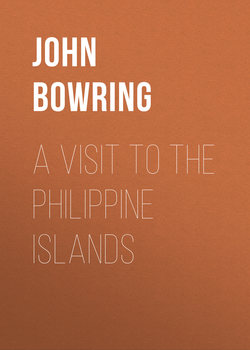A Visit to the Philippine Islands

Реклама. ООО «ЛитРес», ИНН: 7719571260.
Оглавление
Bowring John. A Visit to the Philippine Islands
PREFACE
CHAPTER I. MANILA AND NEIGHBOURHOOD
CHAPTER II. VISIT TO LA LAGUNA AND TAYABAS
CHAPTER III. HISTORY
CHAPTER IV. GEOGRAPHY – CLIMATE, ETC
CHAPTER V. GOVERNMENT – ADMINISTRATION, ETC
CHAPTER VI. POPULATION
CHAPTER VII. MANNERS AND SUPERSTITIONS OF THE PEOPLE
CHAPTER VIII. POPULATION – RACES
CHAPTER IX. ADMINISTRATION OF JUSTICE
CHAPTER X. ARMY AND NAVY
CHAPTER XI. PUBLIC INSTRUCTION
CHAPTER XII. ECCLESIASTICAL AUTHORITY
CHAPTER XIII. LANGUAGES
CHAPTER XIV. NATIVE PRODUCE
CHAPTER XV. VEGETABLES
CHAPTER XVI. ANIMALS
CHAPTER XVII. MINERALS
CHAPTER XVIII. MANUFACTURES
CHAPTER XIX. POPULAR PROVERBS
CHAPTER XX. COMMERCE
CHAPTER XXI. FINANCE, TAXATION, ETC
CHAPTER XXII. TAXES
CHAPTER XXIII. OPENING THE NEW PORTS OF ILOILO, SUAL AND ZAMBOANGA
CHAPTER XXIV. ZAMBOANGA
CHAPTER XXV. ILOILO AND PANAY
CHAPTER XXVI. SUAL
Comintang de la Conquista
Отрывок из книги
Three hundred and forty years ago, the Portuguese navigator Fernando de Magalhães, more generally known by his Spanish designation Magellanes, proposed to Carlos I. an expedition of discovery in the Eastern seas. The conditions of the contract were signed at Zaragoza, and, with a fleet of six vessels, the largest of which was only 130 tons burden, and the whole number of the crews two hundred and thirty-four men, Magalhães passed the straits which bear his name in November, 1520; in the middle of March of the following year he discovered the Mariana Islands, and a few days afterwards landed on the eastern coast of the island of Mindanao, where he was well received by the native population. He afterwards visited the island of Zebu, where, notwithstanding a menaced resistance from more than two thousand armed men, he succeeded in conciliating the king and his court, who were not only baptized into the Catholic faith, but recognised the supreme sovereignty of the crown of Spain, and took the oaths of subjection and vassalage. The king being engaged in hostilities with his neighbours, Magalhães took part therein, and died in Mactan, on the 26th April, 1521, in consequence of the wounds he received. This disaster was followed by the murder of all the leading persons of the expedition, who, being invited to a feast by their new ally, were treacherously assassinated. Guillen de Porceleto alone escaped of the twenty-six guests who formed the company. Three of the fleet had been lost before they reached the Philippines; one only returned to Spain – the Vitoria– the first that had ever made the voyage round the world, and the Spanish king conferred on her commander, Elcano, a Biscayan, an escutcheon bearing a globe, with the inscription, “Primus circumdedit me.” A second expedition, also composed of six vessels and a trader, left Spain in 1524. The whole fleet miserably perished in storms and contests with the Portuguese in the Moluccas, and the trader alone returned to the Spanish possessions in New Spain.
About one hundred and twenty of the expedition landed in Tidore, where they built themselves a fortress, and were relieved by a third fleet sent by Hernan Cortes, in 1528, to prosecute the discoveries of which Magalhães had had the initiative. This third adventure was as disastrous as those which had preceded it. It consisted of three ships and one hundred and ten men, bearing large supplies and costly presents. They took possession of the Marianas (Ladrone Islands) in the name of the king of Spain, reached Mindanao and other of the southern islands, failed twice in the attempt to reach New Spain, and finally were all victims of the climate and of the hostility of the Portuguese.
.....
De Mas’ description of the Manila mode of life is this: – “They rise early, and take chocolate and tea (which is here called cha); breakfast composed of two or three dishes and a dessert at ten; dinner at from two to three; siesta (sleep) till five to six; horses harnessed, and an hour’s ride to the pasco; returning from which, tea, with bread and biscuits and sweets, sometimes homewards, sometimes in visit to a neighbour; the evening passes as it may (cards frequently); homewards for bed at 11 P.M.; the bed a fine mat, with mosquito curtains drawn around; one narrow and one long pillow, called an abrazador (embracer), which serves as a resting-place for the arms or the legs. It is a Chinese and a convenient appliance. No sheets – men sleep in their stockings, shirts, and loose trousers (pajamas); the ladies in garments something similar. They say ‘people must always be ready to escape into the street in case of an earthquake.’” I certainly know of an instance where a European lady was awfully perplexed when summoned to a sudden flight in the darkness, and felt that her toilette required adjustment before she could hurry forth.
Many of the pueblos which form the suburbs of Manila are very populous. Passing through Binondo we reach Tondo, which gives its name to the district, and has 31,000 inhabitants. These pueblos have their Indian gobernadorcillos. Their best houses are of European construction, occupied by Spaniards or mestizos, but these form a small proportion of the whole compared with the Indian Cabánas. Tondo is one of the principal sources for the supply of milk, butter, and cheese to the capital; it has a small manufacturing industry of silk and cotton tissues, but most of the women are engaged in the manipulation of cigars in the great establishments of Binondo. Santa Cruz has a population of about 11,000 inhabitants, many of them merchants, and there are a great number of mechanics in the pueblo. Near it is the burying-place of the Chinese, or, as they are called by the Spaniards, the Sangleyes infieles.
.....